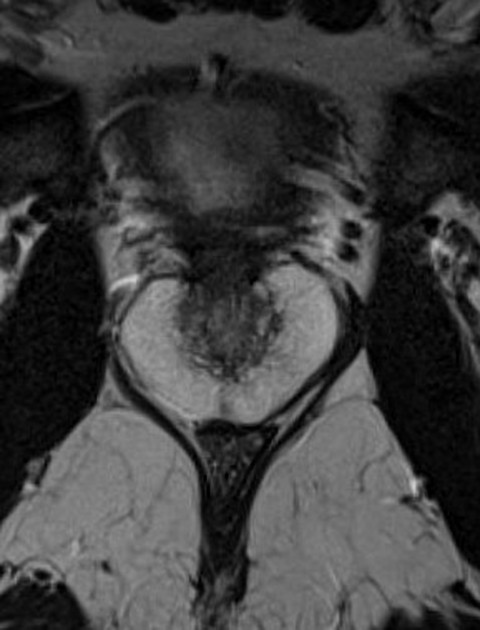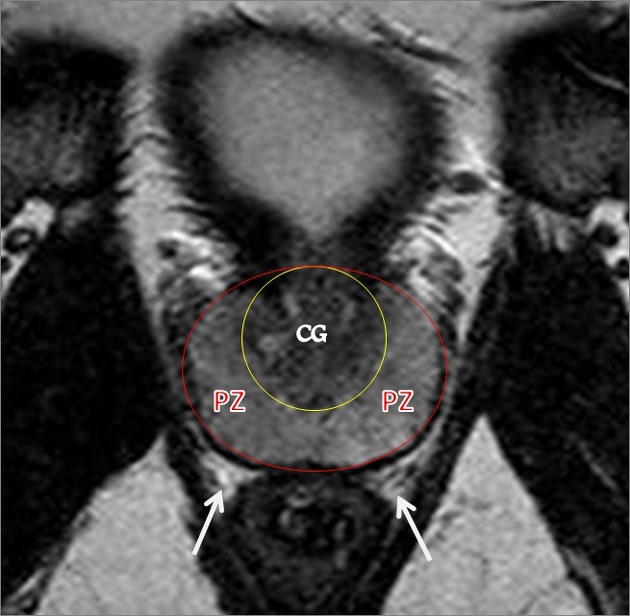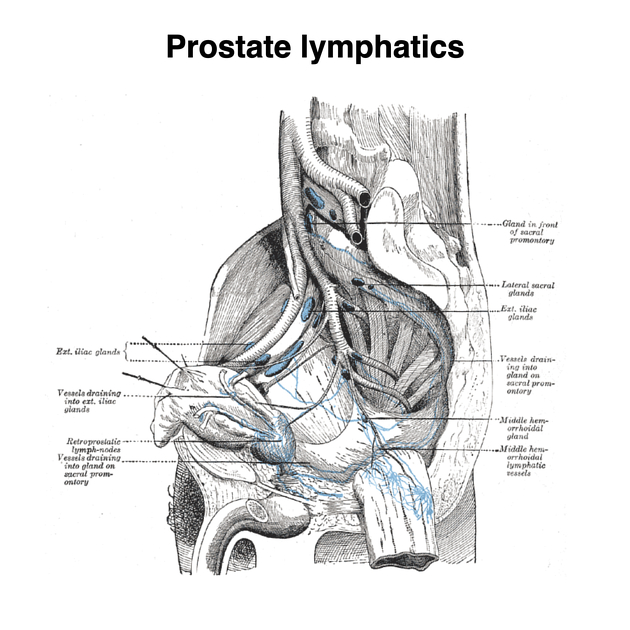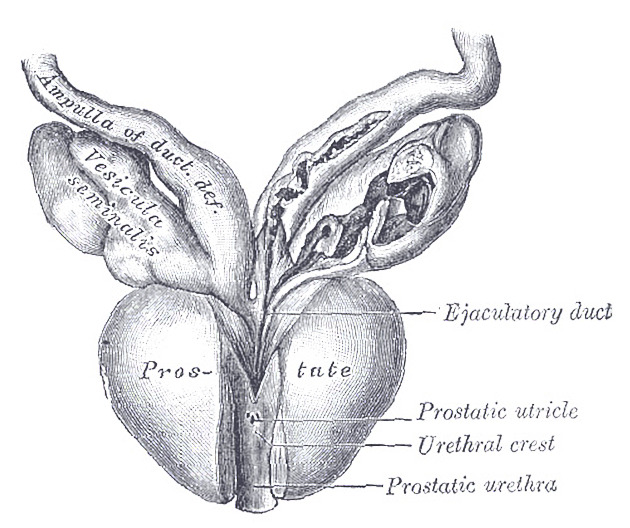prostate







The prostate gland is part of the male reproductive system and is the largest male accessory gland. It typically weighs between 20-40 grams with an average size of 3 x 4 x 2 cm. The prostate is comprised of 70% glandular tissue and 30% fibromuscular or stromal tissue and provides ~30% of the volume of seminal fluid.
Gross anatomy
The prostate gland is an inverted pyramid that surrounds the proximal urethra, which traverses the prostate close to its anterior surface at base and then more centrally. It has a superior base, inferior apex and three surfaces: anterior, inferolateral and posterior. The base of the prostate is in continuity with the bladder. It ends inferiorly at the apex at the urogenital diaphragm .
The anterior surface forms the posterior limit of the retropubic space. The prostate is connected to the pubic bone by the puboprostatic ligaments . Its inferolateral surface rests on the levator ani fascia . Its triangular and flat posterior surface is anterior to the rectum and has a vertical median groove, which is palpable via a digital rectal exam (DRE). It is separated from the rectum by the rectovesical fascia (Denonvilliers’ fascia).
The seminal vesicles are superior and posterior to the prostate gland. Their ejaculatory ducts pierce the posterior surface of the prostate below the bladder and drain into the prostatic urethra.
The prostate gland lacks a true capsule and the so-called prostate capsule is a pseudocapsule formed from fibromuscular tissue surrounding 3 distinct layers of fascia; the anterior, lateral, and posterior fasciae. Anteriorly and apically this pseudocapsule is deficient. Laterally the fascia fuses with the levator fascia. The prostatic venous plexus (Santorini's plexus) lies between and passes through, the pseudocapsule and fascia .
Neurovascular bundles travel posterolaterally at 5 and 7 o'clock and give off branches into the prostate at the apex and base .
Zonal anatomy
The prostate is comprised of three distinct zones with different embryologic origins:
The large cup-shaped peripheral zone (PZ) encompasses the central and transition zones and accounts for approximately 70% of the total prostate volume in a young adult. The peripheral zone surrounds the distal prostatic urethra at the apex of the prostate and extends posterolaterally to the base. The PZ is deficient anteriorly where it is replaced by the anterior fibromuscular stroma (AFMS). Most prostatic tumors occur in the PZ.
The small wedge-shaped central zone (CZ) constitutes up 25% of the prostate volume and contains the ejaculatory ducts. It is posterior to the prostatic urethra and forms the base of the prostate.
The smaller transition zone (TZ) makes up the remaining 5% of the prostatic volume. It is predominantly anterolateral to the prostatic urethra . The transition zone is occasionally written incorrectly as the transitional zone. Benign prostatic hypertrophy occurs in the TZ.
With aging, central zone atrophies and transition zone get hypertrophied.
In older days, the prostate was described the be having five lobes as anterior, posterior, median and two lateral lobes.
Some radiologists and urologists refer to the central gland (CG) which consists of both the central and transition zones. These zones are discernable on MRI.
Relations
- anteriorly: pubic symphysis, retropubic space of Retzius
- posteriorly: rectovesical fascia, rectum
- posterosuperior: seminal vesicles
- superiorly: bladder
- inferiorly: urogenital membrane
- laterally: prostatic venous plexus and levator ani
Arterial supply
- prostatic branch of the inferior vesical artery, a branch of the anterior division of the internal iliac artery
- sometimes supplied by the middle rectal arteries
Venous drainage
- prostatic venous plexus in communication with the pudendal plexus to the deep dorsal vein (to the internal iliac vein) with some communication to the Batson vertebral venous plexus
Lymphatic drainage
- drainage mainly to obturator and internal iliac nodes
- some drainage to external iliac, presacral and para-aortic nodes
Innervation
- parasympathetic (S2-S4) and sympathetic (L1-L2) pelvic nerve plexus
Variant anatomy
- absence of the middle lobe
- presence of a 4 lobe
Radiographic features
Ultrasound
- best assessed with transrectal ultrasound
- some zonal anatomy distinguishable
- outer gland (central and peripheral zones) - uniform low echogenicity but usually more echogenic than the inner gland
- 30 mL is a commonly used upper limit for normal volume
CT
- poor for assessment of prostate zonal anatomy and pathology
- with adjusted window settings
- the central zone appears hyperdense between 40-60 HU
- the peripheral zone appears hypodense between 10-25 HU
- useful for nodal and metastatic staging
MRI
- preferred imaging modality
- T1: homogeneous intermediate signal intensity
- T2
- anterior fibromuscular stroma is low T1W and T2W signal
- peripheral zone is high T2W signal, similar to or greater than adjacent fat
- there are age-related decreases in T2W signal
- central and transition zones are lower T2W signal than peripheral zone
- "capsule" is a thin rim of low signal intensity
- the distal urethra is a small ring of low signal intensity
Development
The central zone forms from the Wolffian duct whereas both the transition and peripheral zones arise from the urogenital sinus .
Related pathology
- prostate calcification
- benign prostatic hypertrophy (BPH)
- prostate cancer
- prostatitis
- prostatic abscess
- emphysematous prostatitis
- prostate cystic disease
- prostate sarcoma
- prostatic utricle cyst
Siehe auch:
und weiter:

 Assoziationen und Differentialdiagnosen zu prostate:
Assoziationen und Differentialdiagnosen zu prostate:
